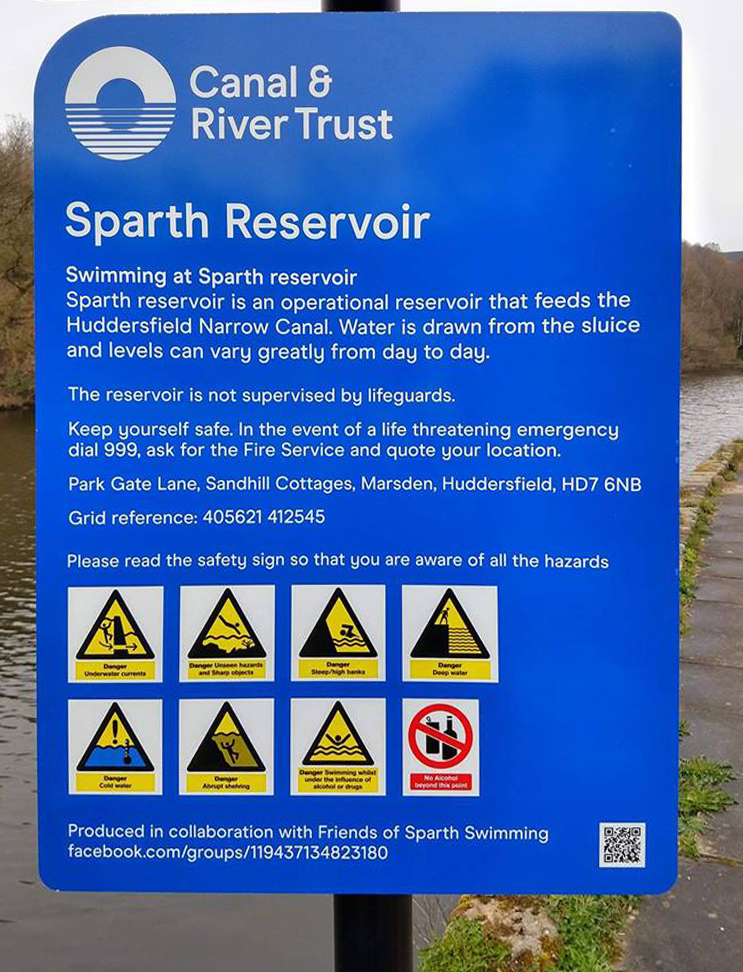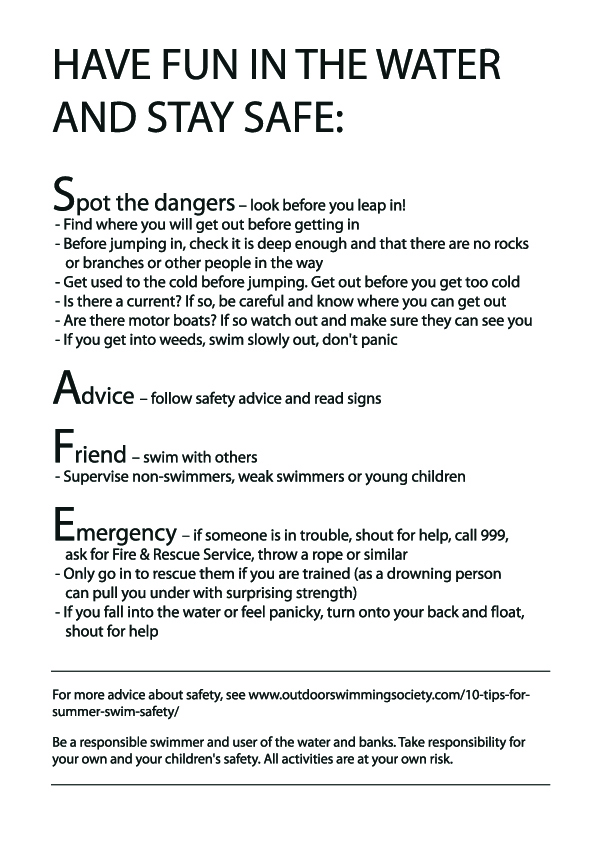We realise that landowners in many places where we swim have concerns about us swimming, and recent conversations have enlightened us on their deeply felt concerns about the safety of people entering lakes, and on the impact it can have on them, their staff and the community if something does go wrong. We also realise that landowners don’t always understand the position on whether they might be liable or responsible, nor about the responsibility of swimmers for risks they might take. We respect and have gained more understanding of these concerns, and would like to allay a number of fears. And we also think that although the impacts – actual or feared – can be great on staff and communities, it is important that policy-making and deciding the approach to swimming on their land is done objectively, based on up-to-date research and the best practice strategies to prevent harm, along with accurate information about risks and the likelihood of harm.
What worries landowners? And some suggestions to allay these fears
- Legal liability and responsibility
- Culpability
- Likelihood of something going wrong if people swim
- Impact if something goes wrong
- Strategies and research on best ways to prevent harm
- Education and information on water safety
- Pressure from others including public opinion or local councils
- Agreements or other factors relating to their land
- Resources – links to useful information
What can be done to deal with these worries and issues?
– the legal position on liability and responsibility
Landowners are not going to be found liable in civil or criminal law if people choose willingly to enter land or water and then come to harm. This is a fundamental legal principle, established in case law, in Latin ‘volenti non fit injuria’, which translates as “to a willing person, injury is not done”, in other words, in civil and criminal law the duty of care owed to a visitor to their land does not apply if someone willingly and knowingly exposes themselves to obvious risk. If there are risks that are not obvious – which would generally mean very unusual aspects that people could not be aware of – and the landowner hasn’t assessed and warned of those, they could potentially be liable. But this would not apply to risks such as cold, depth or variation in depth.
– is the landowner culpable/liable if someone comes to harm?
They would not be liable. Knowing that in itself doesn’t make it much easier to cope with the impact, however it is important to remember that adults are responsible for their own safety and for that of any children or vulnerable people in their care, and also that some incidents can be unavoidable and are not the landowner’s responsibility (for example somebody suffering a heart attack). It is understandable that landowners want to do what they think is best to stop this happening, however the approach often taken of saying stay out of the water to stay safe is unworkable, is not necessary, is unlikely to be the best way to keep people safe and could even be counter-productive.
– how likely is it that people could come to harm?
Nationally there is a very low risk of drowning for people who go swimming. In reality, walking or running by water has a higher risk level, as do angling, boating of all sorts (though all are very low risk), or many day-to-day activities such as cycling or driving on the roads – particularly when you take account of the numbers of people doing these activities. (See analysis by the National Water Safety Forum and Outdoor Swimming Society.)
It is not impossible to have clusters or spikes of incidents in particular places, but this does not mean that the location is inherently dangerous – it’s essential to examine the actual risks and review incidents to see whether they could realistically have been prevented by warning of a non-obvious risk.
Swimming in open water does have risks, with fewer in water bodies such as lakes (whether or not they were previously quarries or reservoirs) with no currents and few obstructions, and particularly when they have gradually sloping beaches giving good exit and entry points (such as many earlier gravel or sand quarries in Norfolk or many reservoirs around the country).
– the impact if something goes wrong for staff and the community
There is no question that someone being injured or dying can have a massive and traumatic impact on the landowner, their staff and the local community. This would be the case whether this happened in water or on the land, or whether they were swimming or fell in, and landowners are not liable, culpable or responsible. It is also extremely distressing for a community if someone dies on their local road or pavement in a crash involving cars or bicycles or pedestrians. Sometimes people affected want to find someone to blame, particularly if something happens in water, while death on the roads seems sometimes to be taken as an inevitable and unavoidable fact of life. Bereavement affects the family, friends and the community, and anyone else who is involved in any way, and grieving, shock and upset are inevitable and can be long lasting. There are support services which can help, including some listed on the government website.
– what is the research and possible strategies to prevent harm?
Detailed research on the causes and circumstances of drowning, broken down into groups, types of water bodies and activities, showing who is likely to be at most risk, is published annually by the National Water Safety Forum in the WAter Incident Database (WAID). The Outdoor Swimming Society has also analysed drowning statistics as they apply to swimmers, and shown that swimming poses a very low risk.
Guidance on strategies helps understand how to ensure water safety while keeping a balance between risks and benefits of people having access to the outdoors and the health and well-being that comes from many outdoor activities including those in water. Landowners are not expected to try to keep people out of water (other than in very limited and extreme situations).
RoSPA provide detailed and helpful advice for assessing the risks for landowners managing areas including or by water, in their guidance (link to download free below). This explains a variety of strategies. It suggests that some measures to try to prevent access can actually make things less safe, and use of lifesaving equipment must be considered very carefully. The guidance also explains liability clearly.
Research on behavioural science and how this affects messaging to people about staying safe can suggest strategies. Telling people they shouldn’t do something and fear inducing strategies not only don’t work in helping people to behave safely but can in fact increase risky behaviour. This can alienate people and make the atmosphere less conducive to people behaving responsibly. The links below include a talk outlining this.
Landowners can use all this guidance, along with assessing the risks at the location, to decide on the best strategy. Although it is difficult to put aside pressures and concerns about the impact if something were to go wrong, strategies decided objectively are more likely to work.
– Can landowners provide education and information on water safety?
The national water safety organisations suggest prioritising key information on water safety, in particular what someone can do if they fall into water or panic when in water (Float to Live), and what to do if someone is in trouble (Call, Tell, Throw, don’t get in to try to rescue). They do not suggest telling people they should stay out of water, realising that is unrealistic and doesn’t provide constructive information.
Landowners should give information to warn if there are unusual/not obvious risks that people couldn’t anticipate but which could be a hazard (this does not include things like cold, depth or variation in depth).
A landowner could choose to (but doesn’t have to) give accurate information to help people avoid coming to harm if they do enter the water, for example on how to avoid the risks from cold or cooler water (go in gradually, stay near shore, don’t get too cold), on deep water (it is essential that anyone going into deep water should be able to swim). However just mentioning risks of cold or deep water without any information on avoiding the risks, or inaccurate information such as on temperature, is just negative and unhelpful, and that could affect credibility or people’s willingness to listen. They could refer to sources that give information on staying safe in water, such as from the Outdoor Swimming Society.
– pressures from public opinion or local councils
Misunderstandings about the safety of swimming, the liability or otherwise of landowners, and risks at a particular location are widespread among society. People have been excluded from water (and to a lesser extent from the outdoors) for generations and given negative and inaccurate information. Many have lost a connection to water and outdoor activities and risks – and knowledge of how to deal with them. This has led to many believing that people should be stopped from doing anything that is perceived as particularly risky (whether it really is or not), and to unrealistic expectations that those in charge or those that own land should keep people safe, even though this is impractical and unrealistic. They might not understand that negative and prohibitive messaging can actually lead to less safe situations. Councils in particular ought to be aware that keeping people away from the outdoors and from water is actually harmful to health and well-being and to understanding of risk (because they have an important role in people’s health).
The more that swimming become seen as a normal activity that millions of people do safely every year, the more people will understand the benefits and the very low risk that it poses.
– what about agreements or other factors relating to their land?
Some land, such as open access land under legislation passed in the year 2000 (or earlier), has a standard position that swimming is not an allowed activity, however that legislation allows landowners to decide to set this aside if they choose (https://www.gov.uk/guidance/open-access-land-management-rights-and-responsibilities#open-your-land-for-public-access). This applies to some land that was originally used for quarrying but then restored to public access, and the same principle can apply to other land even if not specifically defined under the legislation. Landowners want to reduce the chance of problems – for all the reasons outlined. As the research and evidence suggests that an unworkable attempt to prohibit swimming could be less effective in reducing harm they could – and arguably should – choose to set the restriction aside.
GUIDANCE AND USEFUL LINKS
- RoSPA guidance, ‘Managing safety at inland waters guidance’ January 2019, has detailed advice on the law and practical guidance for landowners using case studies, https://www.rospa.com/leisure-safety/water/inland/
- For local authorities, Local Government Association water safety toolkit, https://www.local.gov.uk/topics/community-safety/water-safety-toolkit
- National Water Safety Forum in the WAter Incident Database (WAID), with additional analysis, https://www.nationalwatersafety.org.uk/waid.
- Understanding Drowning Statistics, on the Outdoor Swimming Society website, https://www.outdoorswimmingsociety.com/drowning-statistics/
- National Water Safety Forum’s (NWSF) Water Safety Principles (pdf download) https://www.nationalwatersafety.org.uk/media/1151/water-safety-principles.pdf (based on landowner body VSG principles).
- Visitor Safety Group guidance, ‘Managing Visitor Safety in the Countryside: Principles and Practice’ – a full copy is 10 MB PDF/ https://www.ypdbooks.com/misc/2089-managing-visitor-safety-in-the-countryside-principles-and-practice-YPD02361.html (£20)
- Chapter 2, of Visitor Safety Group guidance, ‘Guiding Principles’ explains how to balance visitor access and safety. (Summary on their website, https://www.visitorsafety.group/principles/guiding-principles/, and see also the NWSF principles).
- Presentation on behavioural change theory at a 2021 RoSPA conference by Dr Fiona Fylan, ‘Using What We Know in Behavioural Science to Help Improve Water Safety’, https://www.youtube.com/watch?v=JIiFT875HEg.
- The Outdoor Swimming Society guidance for landowners, ‘Inland Bathing Areas: a Guide to Setting up Inland Bathing Areas in the UK’, (including case law and discussion of legal liability written by expert legal adviser for OSS), https://www.outdoorswimmingsociety.com/access-all-areas/
- Article pulling together the legal issues on landowner liability and swimmers on this website, https://www.imogensriverswims.co.uk/blog/issues/landowner-liability-and-swimmers/
- Article on OSS website on how reservoirs are suitable for swimming, tackling 16 questions, https://www.outdoorswimmingsociety.com/sixteen-reasons-reservoirs/
- A wide range of swim safety issues on the Outdoor Swimming Society website, https://www.outdoorswimmingsociety.com/category/survive/



Some examples of signage with practical info for swimmers
This was originally published as a post, January Bawsey chilly dip; landowner concerns
